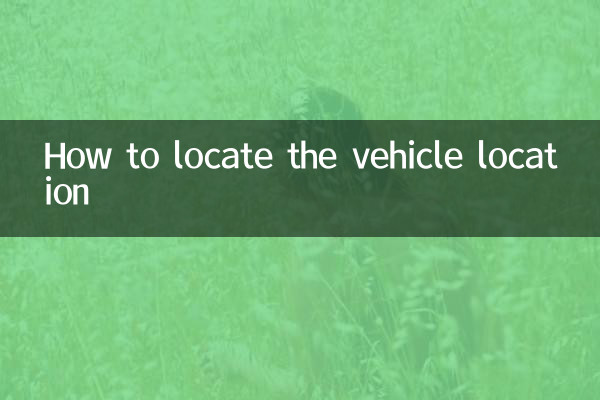Title: How to locate the vehicle location
In today's society, vehicle positioning technology has become an important tool in daily life and business operations. Whether for theft prevention, fleet management or personal convenience, there is a growing need to locate vehicles. This article will introduce in detail the common methods, technical principles and related hot topics of vehicle positioning, and provide structured data for readers' reference.
1. Common methods of vehicle positioning

Vehicle positioning is mainly achieved through the following technologies:
| method | Technical principles | Applicable scenarios |
|---|---|---|
| GPS positioning | Determine the vehicle's latitude and longitude through satellite signals | Personal navigation, fleet management |
| Base station positioning | Estimating location using mobile communication base station signals | Rough location within the city |
| RFID positioning | Reading vehicle tags via radio frequency identification technology | Parking lot management, toll booths |
| OBD positioning | Obtain location data through on-board diagnostic interface | Car rental, insurance tracking |
2. Recent hot topics and hot content
The following are the hot topics on vehicle positioning on the Internet in the past 10 days:
| topic | heat index | Main discussion points |
|---|---|---|
| Electric vehicle anti-theft positioning | 85 | How to choose a cost-effective GPS anti-theft device |
| Online ride-hailing safety monitoring | 78 | How the platform monitors drivers’ driving routes in real time |
| Shared car positioning technology | 72 | Application of new Bluetooth positioning in shared cars |
| Auto insurance UBI pricing | 65 | How to assess driving risk with location data |
3. Vehicle positioning technology selection guide
Selecting the appropriate vehicle positioning technology requires consideration of the following factors:
| Considerations | GPS positioning | Base station positioning | hybrid targeting |
|---|---|---|---|
| Positioning accuracy | High (5-10 meters) | Low (100-1000 meters) | Medium to high (10-50 meters) |
| Coverage | Global | Base station coverage area | Global + base station coverage area |
| Equipment cost | Middle to high | low | high |
| Applicable scenarios | Outdoor precise positioning | Rough location of the city | Full scene positioning |
4. Practical tips for improving vehicle positioning accuracy
1.Update map data regularly: Ensure that the positioning system uses the latest map information to avoid positioning deviations caused by road changes.
2.Install multi-mode positioning equipment: Equipment that supports GPS, GLONASS and Beidou systems at the same time can provide more stable positioning services.
3.Avoid signal interference: Metal car wraps, electronic equipment, etc. may affect positioning signal reception, and positioning equipment should be arranged reasonably.
4.Use assisted positioning technology: In areas with weak GPS signals, auxiliary positioning technologies such as WiFi and Bluetooth can be combined to improve accuracy.
5. Future development trends of vehicle positioning
1.5G high-precision positioning: With the popularization of 5G networks, real-time high-precision positioning technology based on 5G will be widely used.
2.AI trajectory prediction: Artificial intelligence algorithms will be able to predict vehicle driving routes and avoid congestion and dangerous road sections in advance.
3.Blockchain tamper-proof: Use blockchain technology to ensure the authenticity and reliability of positioning data and provide credible evidence for scenarios such as insurance claims.
4.low orbit satellite positioning: The low-orbit satellite network deployed by companies such as SpaceX will further enhance the coverage and accuracy of global positioning.
By understanding the above content, users can have a more comprehensive grasp of vehicle positioning technology and choose the most suitable positioning solution according to actual needs. Whether it is an individual car owner or a corporate user, rational use of positioning technology can bring significant safety assurance and efficiency improvements.

check the details

check the details